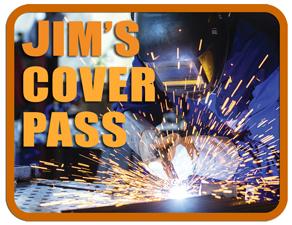Senior Company Trainer
- FMA
- The Fabricator
- FABTECH
- Canadian Metalworking
Categories
- Additive Manufacturing
- Aluminum Welding
- Arc Welding
- Assembly and Joining
- Automation and Robotics
- Bending and Forming
- Consumables
- Cutting and Weld Prep
- Electric Vehicles
- En Español
- Finishing
- Hydroforming
- Laser Cutting
- Laser Welding
- Machining
- Manufacturing Software
- Materials Handling
- Metals/Materials
- Oxyfuel Cutting
- Plasma Cutting
- Power Tools
- Punching and Other Holemaking
- Roll Forming
- Safety
- Sawing
- Shearing
- Shop Management
- Testing and Measuring
- Tube and Pipe Fabrication
- Tube and Pipe Production
- Waterjet Cutting
Industry Directory
Webcasts
Podcasts
FAB 40
Advertise
Subscribe
Account Login
Search
Jim’s Cover Pass: Welding school or learning on the job?
- By Jim Mosman, AWS, CWI/CWE
- July 26, 2018
- Article
- Arc Welding
A: This has been on ongoing debate for as long as I can remember, and it’s something that I experienced firsthand in my own life. I began welding my sophomore year of high school, went to work for a couple years, then realized I had a lot more to learn. I completed a nine-month trade school program and then started my first real welding job.
Speaking as a community college instructor for the past 20 years, my initial recommendation will always be for you to continue your education. However, there are many ways to accomplish this. Community colleges, union schools and apprenticeship programs, private trade schools, on-the-job training, and now even online courses and blogs all have something to offer. The questions you should ask yourself are how do you learn best and what are your career goals? I know just as many good welders who learned on the job as I do welders who earned a degree from welding school.
No matter your age or experience, if you do decide to attend a welding school, there are a few steps for you to consider. First, research the various schools in your area or those that may interest you. Most schools have course descriptions, degree plans, and instructor information available on their websites. Be sure to compare cost and payment options. If the school is away from home, find out the availability of housing and cost of living. Narrow your choices down to the top three or four schools.
The next step is to visit these schools by making an appointment with the instructors and touring the facility. If possible, plan your visit while classes are in session so you can observe student activities. Compare the lab space, number of welding booths, and the variety and quality of equipment available. Find out what the instructor-to-student ratio is for an average class size. Ask about job placement assistance or internship programs. Don’t be afraid to ask questions.
Finally, make your decision based on where you feel the most comfortable and excited after your visit. Once you determine which school you want to attend, contact the admissions office and start that process as soon as possible. I have seen plenty of students who waited until after classes began to enroll only to be disappointed when they found out the class was already full. If you have not decided before you graduate from high school, make that decision now so you can begin in the fall or next class offering.
In the end, no matter how you decide to begin your welding career, surround yourself with experienced welders who are willing to mentor you. Before you know it, you will be helping others learn.
Welcome to this great industry. Work safe, and never stop learning.
Editor's Note: To learn more about how you can pay for trade school, visit https://lendedu.com/blog/student-loans-for-trade-school.About the Author

Jim Mosman, AWS, CWI/CWE
Lincoln Electric Education Division
About the Publication
subscribe now

The Welder, formerly known as Practical Welding Today, is a showcase of the real people who make the products we use and work with every day. This magazine has served the welding community in North America well for more than 20 years.
start your free subscription- Stay connected from anywhere

Easily access valuable industry resources now with full access to the digital edition of The Fabricator.

Easily access valuable industry resources now with full access to the digital edition of The Welder.

Easily access valuable industry resources now with full access to the digital edition of The Tube and Pipe Journal.
- Podcasting
- Podcast:
- The Fabricator Podcast
- Published:
- 04/16/2024
- Running Time:
- 63:29
In this episode of The Fabricator Podcast, Caleb Chamberlain, co-founder and CEO of OSH Cut, discusses his company’s...
- Trending Articles
Sheffield Forgemasters makes global leap in welding technology

ESAB unveils Texas facility renovation

Engine-driven welding machines include integrated air compressors

How welders can stay safe during grinding

The impact of sine and square waves in aluminum AC welding, Part I

- Industry Events
16th Annual Safety Conference
- April 30 - May 1, 2024
- Elgin,
Pipe and Tube Conference
- May 21 - 22, 2024
- Omaha, NE
World-Class Roll Forming Workshop
- June 5 - 6, 2024
- Louisville, KY
Advanced Laser Application Workshop
- June 25 - 27, 2024
- Novi, MI



























